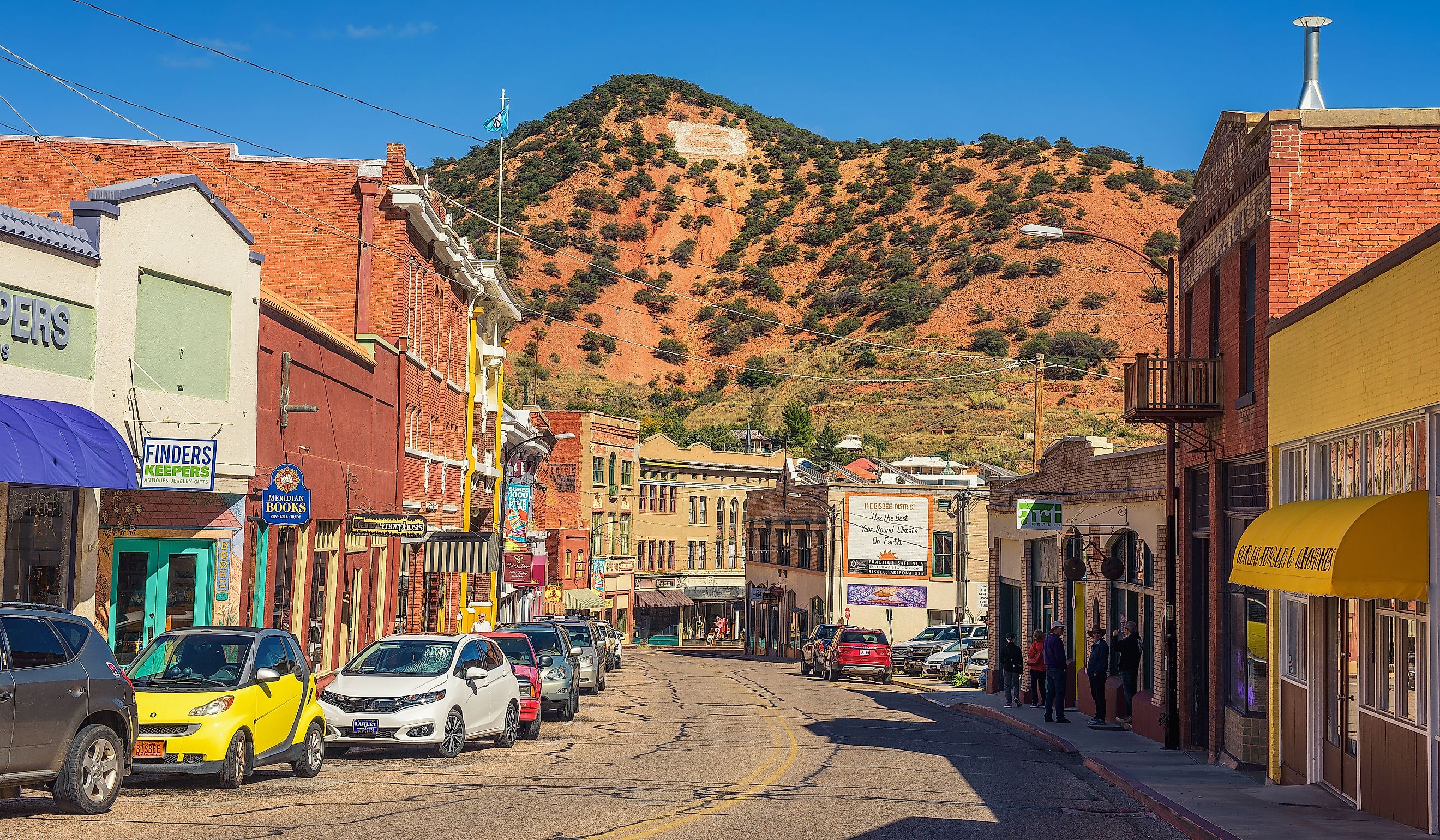
These 11 Towns In Arizona Were Ranked Among US Favorites In 2024
The American Southwest has its share of wonders and attractions, but Arizona stands apart. From red rocks and massive saguaros to welcoming people and fascinating history, the Grand Canyon State truly has something for everyone. Among America's favorites stand eleven special Arizona towns, popular with adventurers, nature lovers, artists, and anyone else who wants to experience one of the most diverse and compelling states in the union. Desert trails lead to art galleries here, and historic saloons share streets with modern museums. Cross into its borders, and you will quickly see how each town adds its own flavor to Arizona's special blend of natural beauty and cultural spirit.
Bisbee
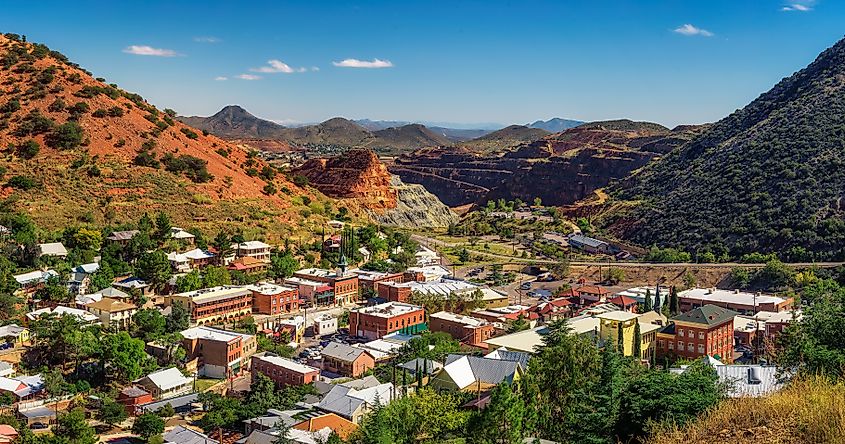
Bisbee ranks among favorite Arizona towns for its intriguing transformation from an old mining town into an arts destination. Set in the Mule Mountains, this former copper mining hub features Victorian buildings now home to art galleries, studios, and cafes. Historic homes line the hillside stairs that connect the town's different levels.
The Copper Queen Mine offers underground tours where retired miners take visitors through tunnels 1,500 feet below ground. At the town's mining peak, these tunnels produced millions in gold and copper. Just a mile east, the Lavender Pit open mine shows the massive scale of Bisbee's mining operations.
The Copper Queen Hotel, built in 1902, towers over most of the other buildings on Main Street. Ghost tours explore its historic halls, while nearby Café Cornucopia and the Bisbee Grand specialize in hearty, homemade dishes that are easy on the wallet. Down the street, the Smithsonian-affiliated Mining Museum, housed in the town's first bank, displays minerals and mining artifacts.
In the 1970s, artists moved into Bisbee's empty buildings. They turned old boarding houses into galleries and former hardware stores into studios. Each October, the Bisbee 1000 stair climb brings athletes to race the town's staircases. Along the mountain roads, weekend motorcycle riders make Bisbee a regular stop on their routes, only adding to the town's unique spirit.
Tubac
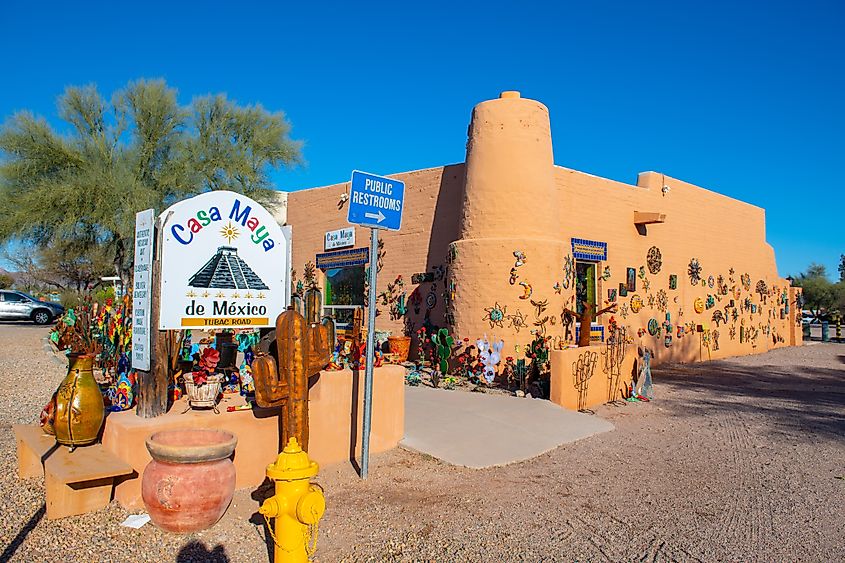
Tubac is another Arizona town ranking among America’s favorites for a compelling blend of history, artistry, and personality. Spanish soldiers built the first presidio here in 1752. These days, artists work in over 100 galleries housed in old adobe buildings between the Santa Rita and Tumacacori Mountains.
Glass panels at Tubac Presidio State Historic Park—Arizona's first state park—show the original fort's foundation right under visitors' feet. Rangers lead tours through restored buildings packed with frontier artifacts. Sitting just four miles south, Tumacácori National Historical Park is another tourist hotspot in the area. Its three mission churches still stand from Spanish colonial days, their thick walls keeping the desert heat at bay.
Artists first discovered Tubac in the 1940s, transforming empty buildings into working studios as word spread about the town's natural beauty. Now, the historic district buzzes with galleries showing everything from oil paintings to handmade jewelry. Some artists work in converted barns, others in old adobe homes. The Tubac Center of the Arts puts on new shows every few months, bringing fresh work to its main gallery.
The Santa Cruz River keeps things green year-round. Birds fill the cottonwoods while hikers follow the Juan Bautista de Anza Trail through the valley. Every February since 1964, the Festival of the Arts takes over town—Arizona's oldest outdoor art market. Small cafes serve chiles rellenos and enchiladas between the galleries. Outside each adobe courtyard, the sound of Spanish still mixes with English, just like it has for centuries.
Payson
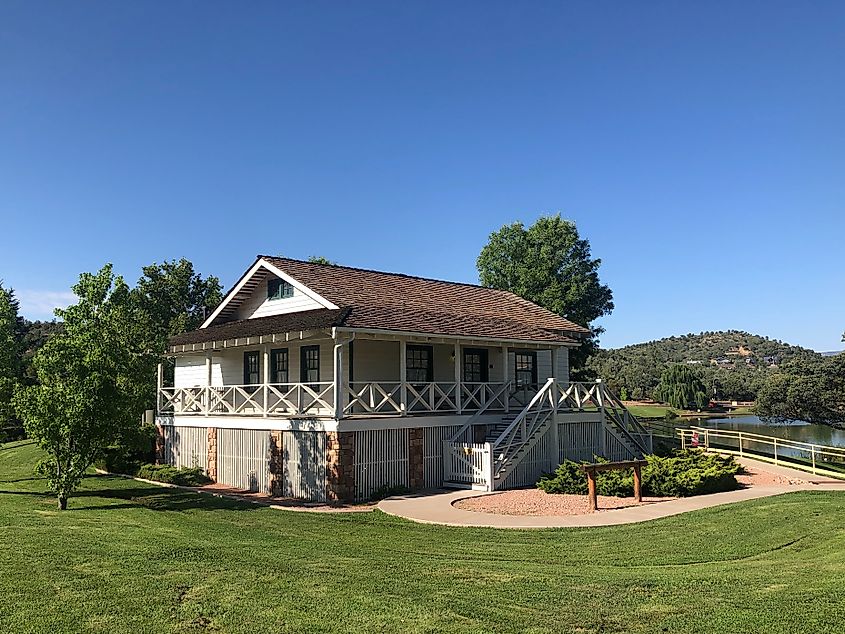
Payson ranks among favorite towns in Arizona for the mountain escape it offers just 90 miles from Phoenix. The town sits at the base of the Mogollon Rim, a dramatic 2,000-foot cliff that stretches across northern Arizona. Pine forests and hidden waterfalls make this high country a perfect break from desert heat.
Tonto Natural Bridge State Park stands as one of Arizona's most striking areas. The park's namesake is the world's largest travertine bridge, stretching 400 feet long and towering 183 feet high. Underneath, hiking paths lead to caves and pools sitting in the massive stone arch's shadow. Water Wheel Falls offers natural swimming holes along the East Verde River, drawing crowds through the warm months.
The Rim Country Museum tells stories of Payson's frontier days through artifacts and exhibits. Next door stands a replica of author Zane Grey's cabin, rebuilt after a fire destroyed the original. Downtown still shows its Western roots, with antique shops and local restaurants filling historic buildings around Main Street. Nearby, the Shoofly Village Ruins give visitors a look even further back, showing how ancient Mogollon people lived in these mountains.
Just west of Payson sits the Mazatzal Wilderness Area, which has over 250,000 acres of rugged country and offers miles of trails for hikers and adventurers. Along Horton Creek, an eight-mile path leads to mountain waterfalls, while Dogtown Lake attracts summer anglers. At Green Valley Park, three fishing lakes and an amphitheater host community events throughout the year. Every August since 1884, the World's Oldest Continuous Rodeo brings cowboys to town, while the state championship fiddle contest adds another layer to Payson's rich mountain heritage.
Cottonwood
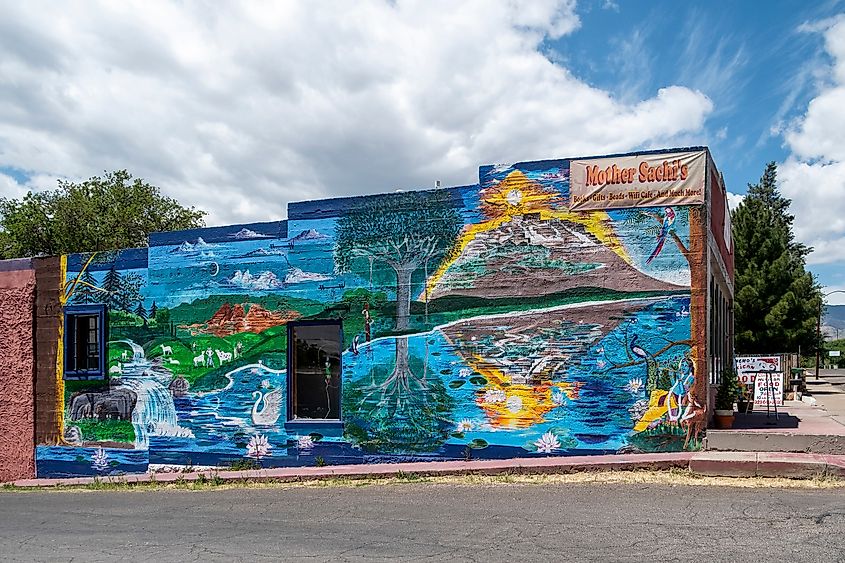
Cottonwood ranks among favorite towns for turning an old farming settlement into a popular wine lovers' destination. The Verde River runs past downtown, creating a green corridor between Sedona's red rocks and Mingus Mountain. In the historic district, old copper mining buildings have found new life as wine-tasting rooms and antique shops.
Along the town's edge, Dead Horse Ranch State Park spans both sides of the Verde River. Trails cut through thick stands of cottonwood trees, leading hikers to spots where rare birds nest near the water. Three fishing lagoons and shaded camping areas draw families throughout the year while bird watchers wander paths through one of Arizona's few riverside forests.
Main Street preserves its early 1900s character in brick and stone. The Cottonwood Civic Center has watched over downtown since 1939, and the old Cottonwood Hotel still stands where it opened in 1917. Local winemakers have turned former mercantile stores into tasting rooms. Each glass poured comes with stories about the building's past life as a mining supply shop or frontier saloon.
Beyond downtown, adventures start at the Verde Canyon Railroad depot in Clarkdale. Vintage cars carry passengers through the canyon country that cars cannot reach. A short drive from downtown, Tuzigoot National Monument's pueblo ruins sit high above the valley. The Sinagua people built these stone rooms 1,000 years ago, choosing this spot for its views of the Verde River. Inside the Clemenceau Heritage Museum, photographs and artifacts show how copper mining built the first roads through this valley, setting the stage for a farming town that found new life in Arizona's growing wine country.
Wickenburg
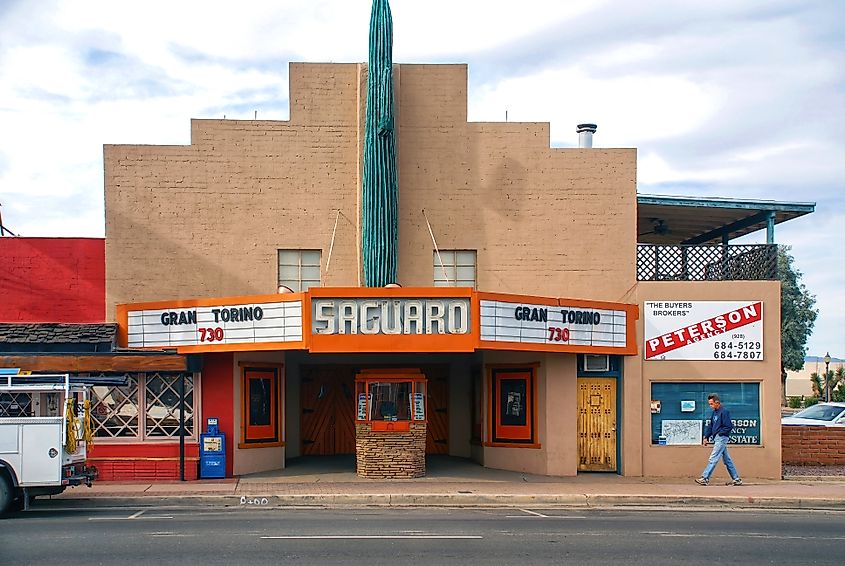
Wickenburg's thriving Western attitude in a patently modern world makes it one of America's favorite towns in Arizona. Sitting where the Sonoran Desert meets the Hassayampa River, this former gold mining hub still draws both cowboys and city folk to its historic downtown and surrounding desert adventures.
The Hassayampa River Preserve protects a rare desert oasis where water flows year-round. Walking paths follow the river under towering cottonwoods, creating a prime real estate for rare desert birds and wildlife. South of town, Vulture Peak rises from the desert floor, offering hikers a challenging climb to views that stretch across waves of saguaro cacti and the Joshua tree forests along U.S. Route 93.
Frontier Street anchors Wickenburg's historic district, where 1800s buildings tell stories of the town's mining days. The 1895 Santa Fe Railroad Depot now welcomes visitors at the Chamber of Commerce, while the Desert Caballeros Western Museum fills its halls with cowboy art and Native American exhibits. The old Jail Tree, a 200-year-old Mesquite, still stands where cowboys once chained outlaws in the days before proper jailhouses.
Rancho Rio and Simpson Ranch keep roping competitions alive in the town known as the "Team Roping Capital of the World." Likewise, historic guest ranches like Rancho de los Caballeros and Flying E Ranch have been offering authentic cowboy experiences like trail rides and cattle drives to visitors since 1948. Each February, Gold Rush Days fills the streets with rodeos and parades, while touring performers at the Del E. Webb Center add modern entertainment to this enduring Western town.
Tombstone
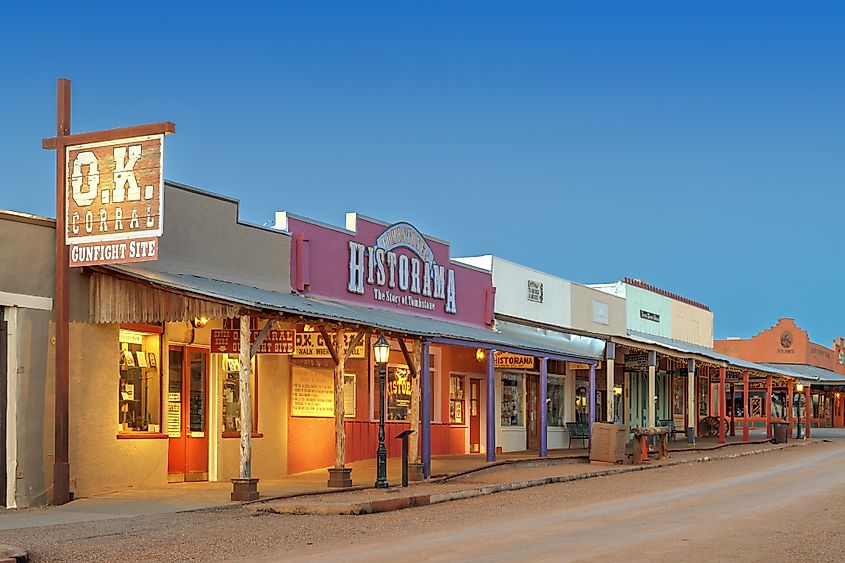
The West never died in Tombstone, and that's exactly why this silver camp turned tourist destination remains one of the essential Arizona favorites. This notorious frontier town still showcases its 1880s character, from creaking wooden boardwalks to the infamous O.K. Corral, where the West's most famous gunfight played out.
Visitors gather at the O.K. Corral several times a day to watch the famous 30-second battle unfold. Local actors recreate the showdown that left three men dead and shaped Tombstone's destiny. A few doors down, the Bird Cage Theatre keeps its 1880s appearance intact, from the original stage to the bullet holes in the walls.
Allen Street forms the heart of the historic district, with preserved 1800s buildings housing saloons and shops beneath covered wooden walkways. The restored courthouse dominates the skyline, and its exhibits walk visitors through the legal drama of Arizona's territorial days. Boothill Graveyard rests quietly on the outskirts, its headstones mixing tragedy and humor in true Western style.
Big Nose Kate's Saloon and the Crystal Palace serve drinks where miners and cowboys once gathered, their bars restored to territorial-day glory. The Helldorado Days celebration each October fills Allen Street with gunfights and period costumes, while stagecoach tours roll past the St. Paul's Episcopal Church, which has held services since 1882. Between the daily reenactments and historic saloons, Tombstone gives visitors a genuine taste of life in one of the Old West's most notorious silver camps.
Sedona
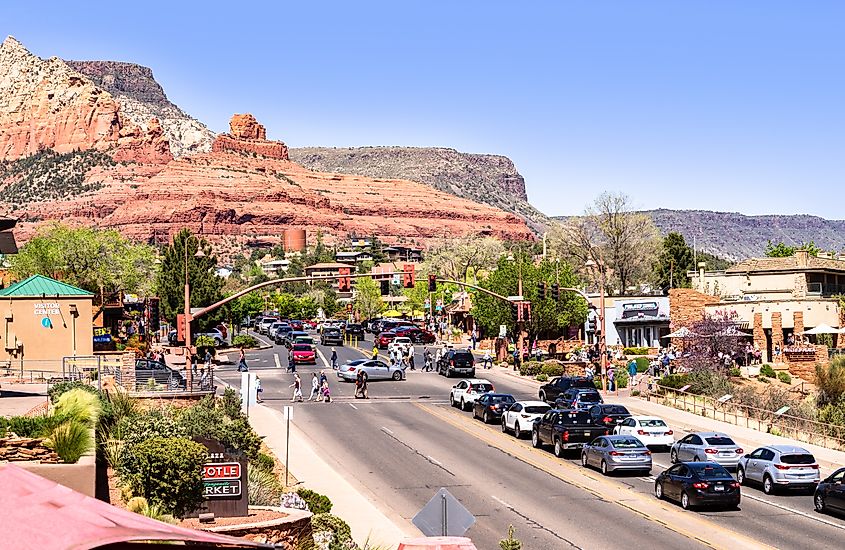
Few places in America blend natural wonder, spiritual energy, and artistic spirit quite like Sedona. This Arizona destination regularly ranks among the country's favorites for good reason—there are not too many places that let you mountain bike past ancient cliff dwellings in the morning, browse world-class art galleries at lunch, and watch the sunset from a chapel built into red rocks.
Sedona stuns first-time visitors. Massive, rust-colored formations rise against bright skies while mountain bikers tackle trails that curve past ancient Native American sites. The Sinagua people built homes on these cliffs 1,400 years ago. Today, hikers and photographers follow paths they once walked.
Airport Mesa gives newcomers their first real look at Sedona's scale. The view spans miles of rust-colored cliffs and green valleys. Jeep tours head out along bumpy trails while families take shorter walks near town. Oak Creek Canyon offers shade and swimming holes just a few minutes north. In fall, the West Fork Trail fills with photographers capturing golden leaves against red canyon walls.
The arts scene boomed when painters discovered Sedona's light in the 1950s. They opened galleries and studios that still line Tlaquepaque's shaded courtyards. This Mexican-style arts district is filled with music and market crowds on weekends. Visitors wander past fountains into shops selling everything from fine art to local crafts. The Chapel of the Holy Cross peers down from its perch in the rocks, drawing curious travelers up winding roads.
Some spots in Sedona draw more than just sightseers. Cathedral Rock and Boynton Canyon attract meditation groups and spiritual seekers. Tourism has grown steadily since the 1980s when people started talking about energy vortexes in the rocks. These days, you will find archaeology walks in the morning, art gallery tours in the afternoon, and mountain bike festivals filling entire weekends. Each season brings something new to discover.
Whether you come for outdoor adventure, artistic inspiration, or spiritual connection, Sedona delivers experiences you will not find anywhere else. Its unique combination of natural beauty, cultural depth, and year-round activities keeps drawing visitors back to discover more.
Williams
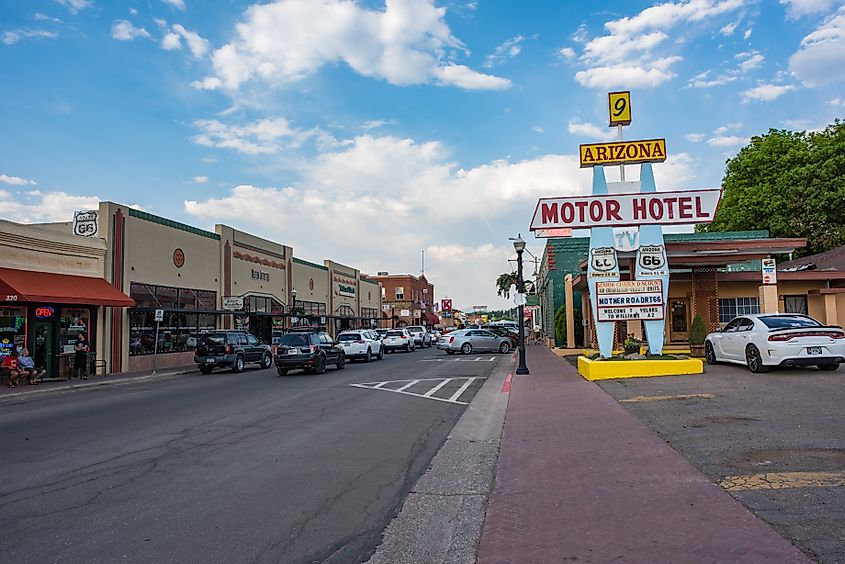
Most people know Williams as the Gateway to the Grand Canyon. This small Arizona town earned its spot among America's favorites by mixing Route 66 nostalgia with outdoor adventure. Vintage neon still glows above historic diners while a restored 1900s train carries visitors through pine forests to the Grand Canyon's South Rim.
Downtown Williams looks like a snapshot of America's past. Shops and restaurants fill buildings that haven't changed much since the heyday of cross-country road trips. The old railway depot sends trains full of excited travelers toward the Grand Canyon each morning, while museums and diners keep Route 66 memories alive. Even after I-40 bypassed Williams in 1984, the town kept its classic American charm alive.
The surrounding Kaibab National Forest offers year-round outdoor escape. Trails wind up Bill Williams Mountain, rewarding hikers with views that stretch forever. Summer visitors cool off at Dogtown and Kaibab Lakes, trading hiking boots for fishing poles and picnic baskets. When snow falls, these same paths transform into winter wonderlands for snowshoers and photographers.
Music spills from local venues every night in Williams. Downtown fills with events throughout the year—classic cars line the streets on summer weekends, while winter brings the magic of the Polar Express. Just outside town, visitors drive through Bearizona Wildlife Park, watching black bears and wolves roam through their native landscapes.
Williams gives visitors exactly what they want from a historic Arizona town—easy access to natural wonders, a dash of Western history, and just enough modern comfort to make everyone feel at home.
Prescott
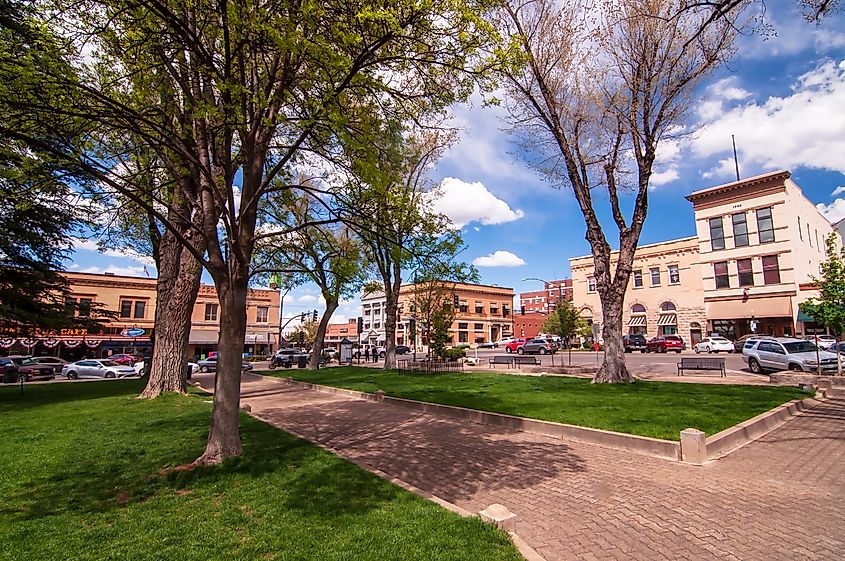
Few places mix Old West heritage with outdoor adventure quite like Prescott. This former territorial capital of Arizona ranks among America's favorites for turning contrasts into character. Visitors spend their mornings climbing ancient granite formations, afternoons browsing Victorian art galleries, and evenings enjoying local brews in historic saloons that survived a 1900 fire.
Prescott's famous Granite Dells set it apart from other mountain towns. These ancient rock formations rise from Watson and Willow Lakes like natural sculptures, drawing photographers, rock climbers, and kayakers to their weathered surfaces. Hikers tackle the 56-mile Prescott Circle Trail, which connects forest paths to lakeside views. The surrounding Prescott National Forest adds camping in summer and skiing in winter.
Downtown wraps around a grassy courthouse plaza, where locals have gathered since territorial days. Markets pop up under old elm trees while musicians play from the gazebo. The plaza's centerpiece, built in 1916, still handles county business in its original rooms. A few blocks away, kids press their faces against the glass at Heritage Park Zoo Sanctuary, watching mountain lions and eagles in their natural habitats.
Whiskey Row tells its own stories. Local saloons survived a massive fire in 1900 and were rebuilt by determined residents who were not ready to give up their favorite watering holes. These days, shops and galleries fill the old brick buildings. Walking tours point out Victorian homes in nearby neighborhoods, each one holding tales of mining fortunes and frontier dreams.
The World's Oldest Rodeo fills Prescott with cowboys and excitement each July, carrying on a tradition from 1888. Down the street, pioneer artifacts and Native American exhibits at the Sharlot Hall Museum help visitors piece together stories of the mountain town's earliest days. Festivals take over the courthouse lawn while tourists duck into art galleries and music venues, mixing past and present in ways that feel perfectly natural.
Between granite cliffs and historic streets, mountain trails and modern galleries, Prescott shows visitors why Arizona's first territorial capital still draws travelers looking for adventure.
Jerome
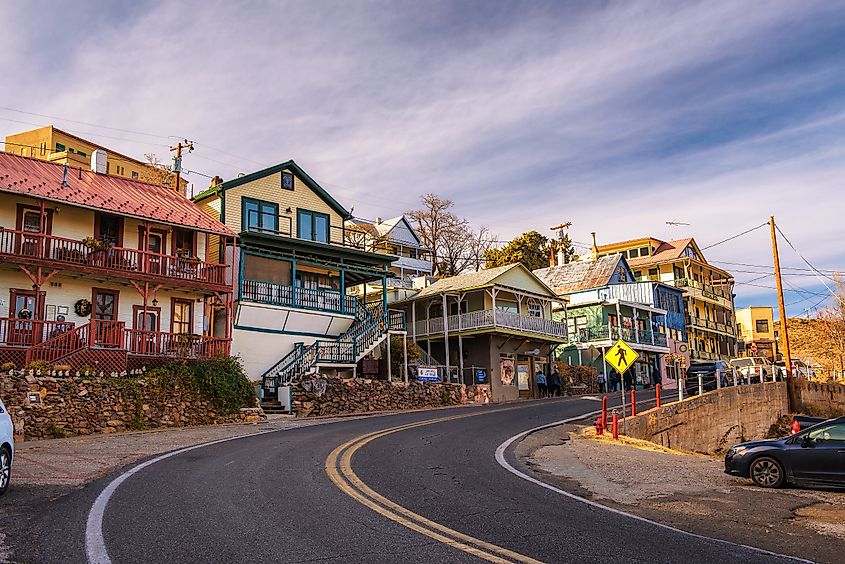
Jerome adds dramatic flair to the list of favorite Arizona towns. This former copper mining hub clings to Cleopatra Hill at 5,200 feet, where historic buildings seem to defy gravity along steep streets. Visitors climb twisted roads to find artists' studios housed in buildings that once served the world's richest copper mine.
The Spanish Mission-style Douglas Mansion rises above Jerome State Historic Park. James Douglas built this showcase home in 1916 during the height of copper mining wealth. Today, museum exhibits fill the restored rooms—mining equipment, period furniture, mineral displays. A detailed 3D model shows the vast network of tunnels beneath the town.
Artists discovered Jerome's potential in the 1970s, turning abandoned storefronts into galleries and studios. Today, the Jerome Artists Cooperative fills a 1917 hotel building with local artwork, from paintings to handcrafted jewelry. Wine-tasting rooms like Caduceus Cellars occupy historic spaces, letting visitors sample Verde Valley wines in buildings that once housed miners.
The Gold King Mine and Ghost Town preserve Jerome's industrial past just outside town. Antique mining equipment rusts picturesquely among over 180 vintage vehicles. A working sawmill still cuts timber while peacocks strut past old trucks and tractors. The Jerome Historical Society Mine Museum on Main Street displays tools and photographs from the town's copper mining heyday.
The United Verde Hospital opened its Spanish Mission-style doors in 1926, perched high above the town. Now, the Jerome Grand Hotel, its halls draw history buffs and ghost hunters. Evening tours wind through Jerome's steep streets as guides share tales from the town's mining days.
Shops and galleries occupy every level of Jerome's vertically-stacked downtown. Blocks away, local wineries pour tastes of Arizona wines in century-old saloons. From its precarious perch, Jerome offers views across the Verde Valley to Sedona's red rocks, proving that even Arizona's ghost towns like to show off the state's rugged good looks.
Page
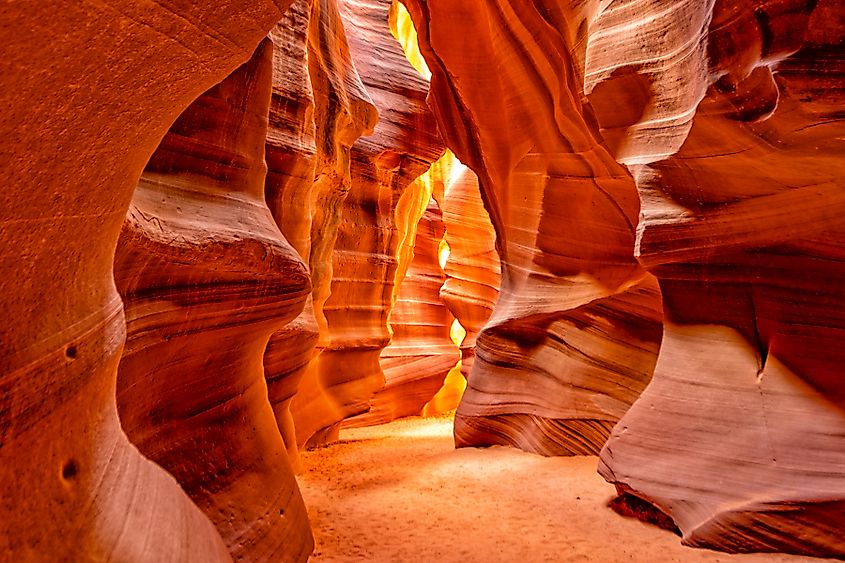
It is obvious why Page is such a favorite Arizona town—it wraps around the southern edge of Lake Powell, showcasing bright red rock cliffs as they meet crystal blue water. Boats leave the marina hourly, some heading for Antelope Canyon, others toward Glen Canyon Dam, while families in houseboats find quiet coves to anchor.
Visitors drive past the dam on their way into town. This concrete giant created Lake Powell in the 1960s. Tours show off its inside workings, and river rafters gather below to start their Grand Canyon trips.
The road south of Page leads to one of Arizona's most photographed spots. Cars fill the Horseshoe Bend parking lot by mid-morning. Hikers take the sandy path to the rim, cameras ready. From the edge, they see the Colorado River curve in a perfect U-shape far below, cutting deep into red rock.
Local Navajo guides lead tours into Antelope Canyon. These narrow slot canyons twist through sandstone, barely wide enough to walk through in some spots. Sun beams light the gaps between smooth rock walls, creating dramatic views that make these canyons famous.
The Page Balloon Regatta brings color to the town every October, where hot air balloons float over canyon walls, and boats check out the scene from the lake that defines life in Page. Spring through fall, boat ramps stay busy with fishing guides heading out every morning and houseboats lining the marina's docks. At night, the dark desert nights show off clear skies full of stars—exactly what visitors expect from a small but vibrant Arizona town like Page.
Arizona's allure runs deeper than desert views and sunny skies. Between thousand-foot cliffs and hidden art galleries, mountain trails, and historic main streets, these towns show why the Southwest captures imaginations like nowhere else. Its personality and beauty create a gravitational pull that affects any person who crosses its borders. That pull is exactly why some visitors come for a weekend getaway and end up staying years—they cannot help but immerse themselves in the state’s rare mix of natural wonders, small-town welcome, and charisma. In Arizona, first-time tourists turn into lifetime loyalists every day, giving in to the Grand Canyon State’s special way of life.











